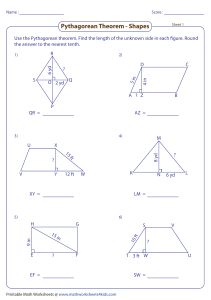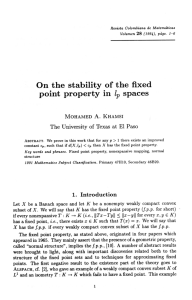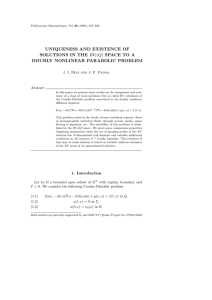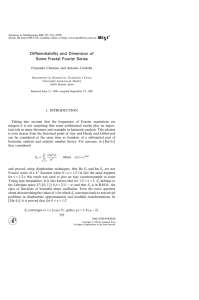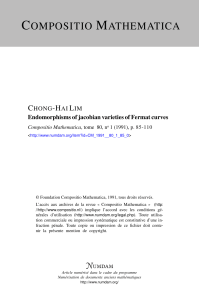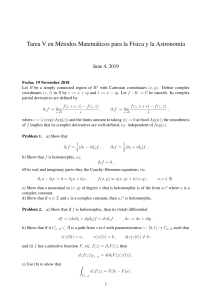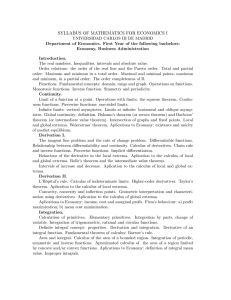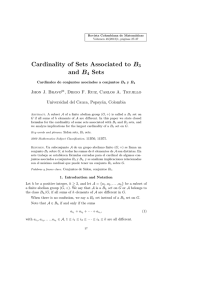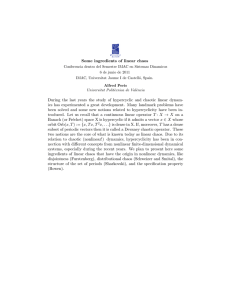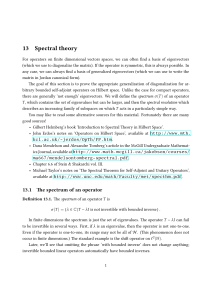el problema de transmisión con coeficientes dependientes del
Anuncio
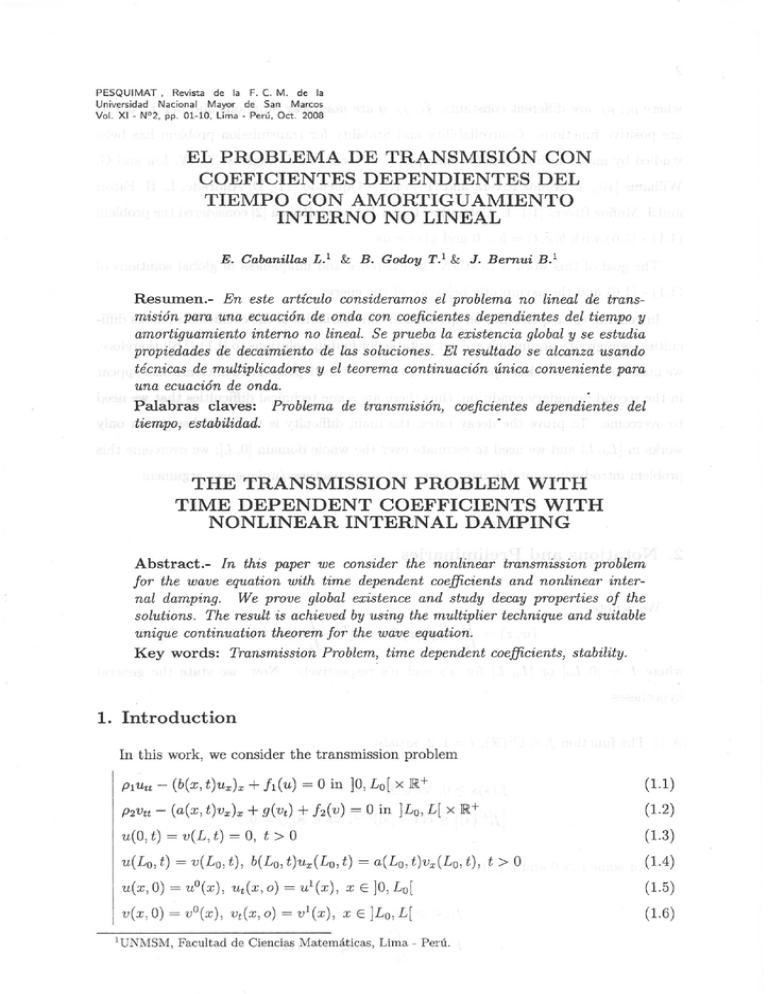
PESQUIMAT,
Revista de la F. C. M. de la
Universidad
Nacional Mayor de San Marcos
Vol. XI - N°2, pp. 01-10, Lima - Perú, Oct. 2008
EL PROBLEMA DE TRANSMISIÓN CON
COEFICIENTES DEPENDIENTES DEL
TIEMPO CON AMORTIGUAMIENTO
INTERNO NO LINEAL
E. Cabanillas L.l & B. Godoy T.l & J. Bernui B.l
Resumen.- En este artículo consideramos el problema no lineal de transmisión para una ecuación de onda con coeficientes dependientes del tiempo y
amortiguamiento interno no lineal. Se prueba la existencia global y se estudia
propiedades de decaimiento de las soluciones. El resultado se alcanza usando
técnicas de multiplicado res y el teorema continuación única conveniente para
una ecuación de onda.
Palabras claves:
tiempo, estabilidad.
Problema de transmisión,
coeficientes dependientes
del
THE TRANSMISSION PROBLEM WITH
TIME DEPENDENT COEFFICIENTS WITH
NONLINEAR INTERNAL DAMPING
Abstract.- In this paper we consider the nonlinear transmission problem
for the wave equation with time dependent coefficients and nonlinear internal damping.
We prove global existence and study decay properties of the
solutions. The result is achieved by using the multiplier technique and suitable
unique continuation theorem for the wave equation.
Key words: Transmission
Problem, time dependent coefficients, stability.
1. Introduction
In this work, we consider the transmission
PIUtt - (b(x, t)u:zJx
P2Vtt - (a(x, t)vx)x
+ f¡(u) = O in
+ g(Vt) + h(v)
problem
(1.1)
]0, Lo[ x jR+
=
(1.2)
O in ]Lo, L[ x jR+
(1.3)
u(O, t) = v(L, t) = O, t > O
u(Lo, t) = v(Lo, t), b(Lo, t)ux(Lo, t) = a(Lo, t)vx(Lo, t), i
u(x, O) = uO(x), Ut(x, o) = u1(x),
v(x, O) = vO(x), Vt(x, o) = v1(x),
1UNMSM,
Facultad
X
X
»O
(1.4)
E
]0, Lo[
(1.5)
E
]Lo, L[
(1.6)
de Ciencias Matemáticas,
Lima - Perú.
2
fr, 12, 9 are nonlinear functions and a(x, t), b(x, t)
where Pl, P2, are different constants,
are positive functions.
Controllability
and Stability for transmission
problem has been
studied by many authors (see for example J. L. Lions [9], J. Lagnese [7], W. Liu and G.
Williams [10], J. Muñoz Rivera and H. Portillo Oquendo [11]' D. Andrade, L. H. Fatori
and J. Muñoz Rivera [1]). E. Cabanillas L and J. Muñoz Rivera [2] considered the problem
(1.1) - (1.6) with b(x, t) = b >
°
and g(s) = as.
The goal of this work is to study the existence and uniqueness of global solutions of
(1.1) - (1.6) and the asymptotic
behavior of the energy.
In general, the dependence on spatial and time variables of the coefficients causes difficulties, semigroups arguments are not suitable for finding solutions to (1.1)-(1.6); therefore,
we make use of a Galerkin's process. Note that the timedependent
coefficients also appear
in the second boundary condition, thus there are some technical difficulties that we need
to overcome.
To prove the decay rates, the main difficulty is that the dissipation
only
works in [Lo, L] and we need to estimate over the whole domain [O, L]; we overcome this
problem introducing
suitable multipliers and a compactnessjuniqueness
argumento
2. Notations and Preliminaries
We denote
(w, z)
=
1
Izl2
w(x)z(x)dx,
~
llz
(x)12
where 1 = ]0, La[ or ]La, L[ for u's and v's respectively.
dx
Now, we state the general
hypotheses.
(A.1) The function fi E
el (IR),
i
fi(s)s
!fF)(s)!
for some e >
°
=
1, 2, satisfy
2: 0, Vs E IR
< c(l + Isl)P-j,
Vs E IR, j = 0,1
and P 2: 1.
fr(s)
2: 12(s)
Fi(S) =
¡S
fi(~)d~,
i
= 1,2
3
(A.2) Assumptions
on the coefficient a
b,
aE
Wl,OO(a,
bt, at E Ll(O,
00;
00;
el(I))
n W2,OO(0, 00; Loo(I))
Loo(I))
b(x, t) 2: bo > 0, a(x, t) 2: ao > 0, V(x, t) E 1 x ]0, oo[
(A.3) Let 9 : lR ~ lR be a nondecreasing
el function such that
g(8).8 > 0, for all
and there exist
Ci
°
8 =1=
> 0, i = 1,2,3,4 such that
where p 2: 1
By V we denote the Hilbert space
v=
{(w, z) E Hl(O, Lo) x
n'iu; L)
: w(O) = z(L) = O; w(Lo) = z(Lo)}
By El and E2 we denote the first order energy associated to each equation,
~ {Pl
21
LO
IUtl2 + (b, u;) +
Hp"v,,' +
(a, v;)
El(t, u, v)
El(t, u)
=
+2
F1(u)dx }
f
F,(V)dX}
+ E2(t,
v).
We conclude this section with the following lemma which will play essential role when
establishing the asymptotic
behavior.
Lemma 2.1 Let E : lRt ~ lRt be a non-increasing
two constants p >
° and > ° such that
function and assume that there exists
e
{+OO
l,
+1
ET(t)dt::;
CE(8) ,
u<
8
<
+00
4
then we have
2
E(t)
< cE(O)(l -+-t)-P-l , for all t.> O ifp > 1
E(t)
< cE(O)e1-wt,
where e and w are positive
for all t "2 O if P
=
1
constants.
Proof. See reference [[4J Lema 9.1J.
3. Existence and Uniqueness of solutions
First of all, we define what we will understand
ofweak solutions ofproblem (1.1) - (1.6).
Definición 3.1 We say that the couple {u, v} is a weak solution
of (1.1) - (1.6) when
and satisfies
jL (x)'Ij;(x, O)dx
UO(x)ipt(x, O)dx - P2
¡Lo° u1(x)ip(x, O)dx + Pl ¡LO
°
Lo
L
¡T¡LO
+ P2 j VO(x)'Ij;t (x, O)dx + Pl
(Uiptt + b(x, t)uxipx + fl(U)ip)dxdt
~
° °
+ P2 {T jL (v'lj;tt + a(x, t)vx'lj;x + g(Vt)'Ij; + h(v)'Ij;)dxdt
O
lo Lo
- Pl
VI
=
for any {ip, 'ljJ}
E
C2(O, T; V) such that ip(T) = ipt(T) = O = 'Ij;(T) = 'lj;t(T)
In order to show the existence of strong solutions we need a regularity
result for
the elliptic system associated to the problem (1.1) - (1.6) whose proof can be obtained,
with little modifications,
theorem 16.2).
in the book by O.A. Ladyzhenskaya
and N. N. Ural'tseva;
([5],
5
Lema 3.2 Por any given functions
F
E
L2(O, Lo), G
E
L2(Lo, L), there exists only one
solution {u, v} of
F in ]0, Lo[
-(b(x, t)vx)x
-(a(x,
t)vx)x
-
u(O, t)
G in ]Lo, L[
v(L, t)
u(Lo, t)
=O
v(Lo, t), b(Lo, t)ux(Lo)
=
a(Lo, t)vx(Lo)
with t a fixed value in [O, T] satisfying
The existence result to the system (1.1) - (1.6) is summarized in the following theorem.
Theorem 3.3 Suppose that {uO,vO} E V,
assumptions
{U1,V1}
E
L2(O,Lo) x L2(Lo,L)
and that
(A.l) - (A.3) hold. Then there exists a unique weak solutiont of (1.1) - (1.6)
satisfying
In addition, if {UO, VO} E H2(O, Lo) x H2(Lo,L),
{U1,V1} E
V, verifying the compati-
bility condition below
Then
En
2
{u,v}
Wk,OO(O,T,H2-k(O,
Lo) x H2-k(Lo,L))
k=O
Proof. The main idea is to use the Galerkin Method.
6
4. Main Result: Exponential Decay.
In this section we prove that the solution of the system (1.1) - (1.6) decay exponentially
as time ~Ges tu iañmty. ln the remainder of this paper we denote by e a positiva constant
which takes different values in different places. We shall suppose that Pl ::; P2 and
b(x, t)
a(x, t)
,ax(x, t)
b > 0, V(x, t)
E
]0, Lo[ x ]0, oo]
< b, at(x, t) ::; O, V(x, t)
<
E
]Lo, L[ x ]0, oo]
i(i)
u~(Lo)
=
°
then there exisis positive constants ry and e suchthat
E(t) < cE(O)e-¡t , Vt 2:: O.
We shall prove this theorem for strong solutions; our conclusion follow by standard
density arguments.
The dissipative property of system (1.1) - (1.6) is given by the following lemma.
Lemma 4.2. The first arder energy satisfies
Proof. Multiplying equation (1.1) by
Ut,
equation (1.2) by
Vt
and performing an integra-
tion by parts we get the resulto
Let'l/J E
CoCO,
L) be such that
'IjJ =
1 in ]Lo - 5, Lo
+ 5[ for some
5> O,small constant.
7
Let us introduce the following functional
where q(x) = x.
Lemma 4.3. There exists
[or any
el
> O sueh that
E> O.
Proof. Multiplying
equation (1.1) by quX) equation
and using the corresponding
(1.2) by 'ljJqvx integrating
boundary conditions we obtain the lemma.
Let rp E COO(IR) a nonnegative function such that rp = Oin h/2 = ] Lo - ~) Lo
ip = 1 in
IR \ le, and consider the functional
We have the following lemma
Lemma 4.4. Given
f
by parts
> O, there exists a positive eonstant e, sueh that
Let us consider the following functional
K(t) = l(t)
+ (2e1 + l)J(t)
+ ~[ and
8
and we take
E
=
El
in lemma 4.4, where
taking in consideration
El
is the solution of the equation
(A.1) in lemma 4.3 we obtain
Now in order to estimate the last two terms of (4.1) we need the following result
Lemma 4.5. Let {u, v} be a solution in theorem 3.3 Then there exists To > O such that
ifT ~ To we have
for any
E
>
O and
Cf
is a constant depending on T and
any initial data {uO,vO}, {ul,vl} sattsfying E(O,u,v)
O < S <T <
E,
by independent of {u, v}, for
:::;R, where R > Ois fixed and
+00.
Proof. We use a contradiction
method.
(to see [3].)
Proof of theorem 4.1 Let us introduce the functional
L(t) = N E(t) + K(t)
with N> O. Using Young's Inequality and taking N large enough we find that
(4.2)
for some positive constants
eo and el'
Applying the inequalities
integrating
(4.1) and (4.2), along with the ones in Lemma 4.5 and
from S to T where O :::;S :::;T <
lsT E(t)dt
00
we obtain
S cE(S).
9
In this condition, lemma 2.1 implies that
< cE(O)e-
rt
E(t)
this completes the proof.
5. Polynomial Decay.
In this section we study the asymptotic
(1.6) when the function g(s)
behavior of the solutious of system (1.1) -
is non-linear in a neighborhood
In this case we shall prove that the solution decays like (1
Theorem 5.1 With the hypotheses in theorem
polynomially,
4.1
to zero like sP with p > 1.
+ t)-2(P-l).
and p. > 1 the weak solution decays
i. e.
E(t) = CE(O)(l
+ tt2/(P-l),
Vt ~ O
Proof. From (A.3) and making use of Hólder's inequality, theorem follows.
Remark. If we consider, in (1.2), a linear localized dissipation a = a(x) E C2(]Lo, L[),
a(x) = 1 in]Lo,Lo+8[,
a(x)
need a new unique continuation
This is in preparation
= O in ]Lo+28,L[
our situation
is very delicate and we
theorem for the wave equation with variable coefficients.
by the authors.
.
10
REFERENCES
[1] Andrade D., Fatori, L. H. and Rivera, J. E. - Nonlinear transmission Problem with a
Dissipative boundary condition of memory type, Elect. J. DifF. Eq, vol 2006 (2006)
N 53, pp. 1-16.
[2] Cabanillas, L. E. and Rivera, J. E. - A Nonlinear Trausmission Problem with Time
Dependent Coefficienis, Elect. J. Diff. Eq, vol 2007 (2007) N 131, pp. 1-13.
[3] Cabanillas L.E. - A Transmission Problem with Time Dependent Coefficienis.
[4] Komornik, V. - Exaci Controllabiliiy and Siabilizaiion; The multiplier method, Masson. Paris, 1994.
[5] Ladyzhenskaya,
O. - Linear and Quasilinear Elliptic Equations, Academic Press,
New York, 1968.
[6J Lasiecka, 1. and Tataru, D. - Uniform boundary Siabilization
of Semilinear wave
Equations wiht Nonlinear Boundary Damping, Differential Integ. Eq. 6(3)(1993),
pp. 507-533.
[7] Lagnese, J. - Boundany Controllability in Problem of Transmission for a class of
second order Hyperbolit Systems, ESAIM: Control, Optim and Cal. Varo 2(1997),
pp. 343-357.
[8J Lions, J. L. - Quelques Methodes de Résolution dés Résolution
limites Nonlineaires, Dunod, Gaulthier - Villars, Paris, 1969.
[9] Lions, J. L. - Controlabiliié Exacte, Perturbations et stabilization
tribués (tome 1), collection RMA, Masson, Paris 1988.
dés problémes aux
de Systems Dis-
[10] Liu, W. - The exponential, The exponential stability of the problem of transmission
of the wave equation, Bulletin of the Austral. Math. Soco 57(1998), pp. 305-327.
[11] Munoz R. and Oquendo H. P. - The transmission
Act. Appl. Math. 62 (2000), pp. 1-21.
probiem of Viscoelasiic Waves,
[12J Ruiz A. - Unique Continuation for weak Solutions of the wave Equation plus a
Poiential, J. Math. Pures Appl. 71 (1992), pp. 455-467.

